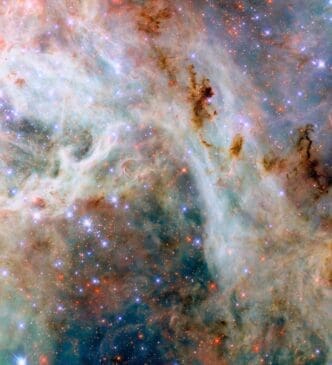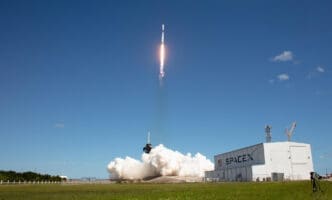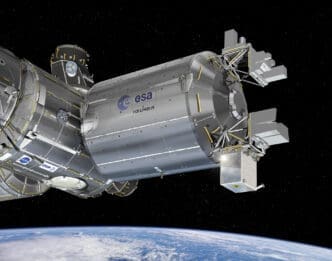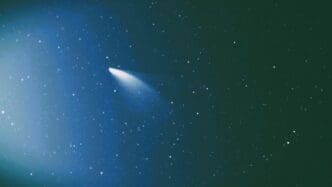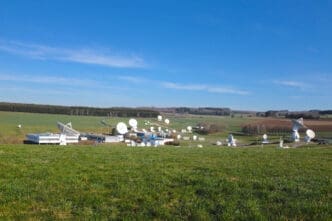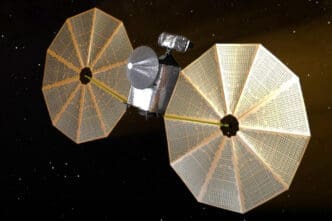The Hubble Space Telescope has amazed us yet again with a stunning image of cosmic clouds near the Tarantula Nebula. This celestial masterpiece lies in the Large Magellanic Cloud, around 160,000 light-years away. Offering a glimpse into the universe’s dusty wonders, it’s a sight to behold.
This remarkable capture showcases swirling gases and dust. Nestled between constellations Dorado and Mensa, the Tarantula Nebula is known for its star-forming prowess. It hosts some of the cosmos’s biggest stars within its colorful, dusty embrace.
The Tarantula Nebula’s Stellar Secrets
Incredible cosmic structures appear in Hubble’s image, revealing the Tarantula Nebula’s stellar secrets. This nebula isn’t just stunning; it’s functional, serving as a star factory in the universe.
Home to huge stars, the Tarantula Nebula sparkles with youthful energy. These young stars grow from the nebula’s swirling dust and gas, showcasing nature’s celestial wonders.
Cosmic Dust: More Than Meets the Eye
The dust captured by Hubble isn’t like any dust found at home. Cosmic dust is unique, made up of complex molecules that include elements like carbon.
Cosmic dust in Hubble’s image plays a vital role in space. It cools gas clouds, aiding star formation, and helps atoms bond to form new molecules.
While household dust might alarm allergy sufferers, cosmic dust sparks curiosity. It’s a critical component of the universe’s vast tapestry, enabling life and celestial creation.
From Dusty Clouds to Forming Stars
Cosmic dust leads a grand cosmic dance, forming stars over time.
These dust clouds offer a perfect setting for star creation. Dust grains coalesce, ultimately forming planetary bodies. It’s a cosmic marvel.
The entire process is awe-inspiring and monumental. Dust grains, though tiny, play a colossal role in the grand design of the universe.
The Importance of Dust in Space
A realm of cosmic discovery unfolds with each particle of space dust.
These dust particles, despite their size, are vital. They assist in cooling down gases, allowing new stars to emerge.
Dust is more than a celestial nuisance; it’s essential for cosmic evolution.
The beauty of the universe might partly rest in these tiny grains. They are small, but their role is vast and essential.
Hubble’s Role in Unveiling the Cosmos
Hubble’s mission extends far beyond photographs. Each image helps piece together the universe’s grand puzzle.
Through decades of observation, Hubble has enriched our understanding of star and planet formation. It’s a window to the mysterious, boundless cosmos.
The telescope’s technological capabilities enable us to peek into distant galaxies, shedding light on cosmic mysteries.
Hubble continues to broaden horizons. Its contributions to astronomy are invaluable.
The Large Magellanic Cloud: A Cosmic Neighbor
The Large Magellanic Cloud, home to the Tarantula Nebula, is a nearby galaxy filled with wonders.
Hubble’s observations of the Large Magellanic Cloud show us a glimpse of cosmic life beyond our galaxy.
This galaxy, close in astronomical terms, offers insight into star births and deaths.
It’s a window to observe processes that shape galaxies. Observing it helps us understand cosmic history.
The Large Magellanic Cloud serves as a laboratory for studying cosmic phenomena. Hubble’s data furthers our celestial knowledge.
Spinning Threads of the Universe
The universe’s fabric holds dust and gas tightly woven together.
This intricate dance between dust and gas forms a star song. Each thread spins to create life.
Hubble catches these cosmic tangos in images, showing us the ever-performing universe.
Cosmic fabric is ever-changing. Each reconfiguration sparks wonder and advances cosmic understanding.
Interstellar Chemistry on Display
Cosmic dust contributes to complex chemistry in space.
These grains host chemical reactions that wouldn’t happen elsewhere, creating new stellar materials.
Hubble’s images reveal this interstellar chemistry in action.
Seeing these processes in Hubble’s data provides a peek into the chemical complexity of space.
This adds layers to our understanding of how stars and planets come to be.
Even the smallest cosmic grain plays a part in universal creation.
Dust: Building Blocks of Planets
Stars aren’t the only things that owe their existence to cosmic dust. Planets also benefit from these humble grains.
As dust gathers, it clumps into larger structures, eventually forming planets and moons. Cosmic dust’s role is critical.
Hubble’s images reveal the celestial dance of dust and gas, illustrating the universe’s dynamic nature. Through these captivating visuals, we understand cosmic chemistry and star formation better.

